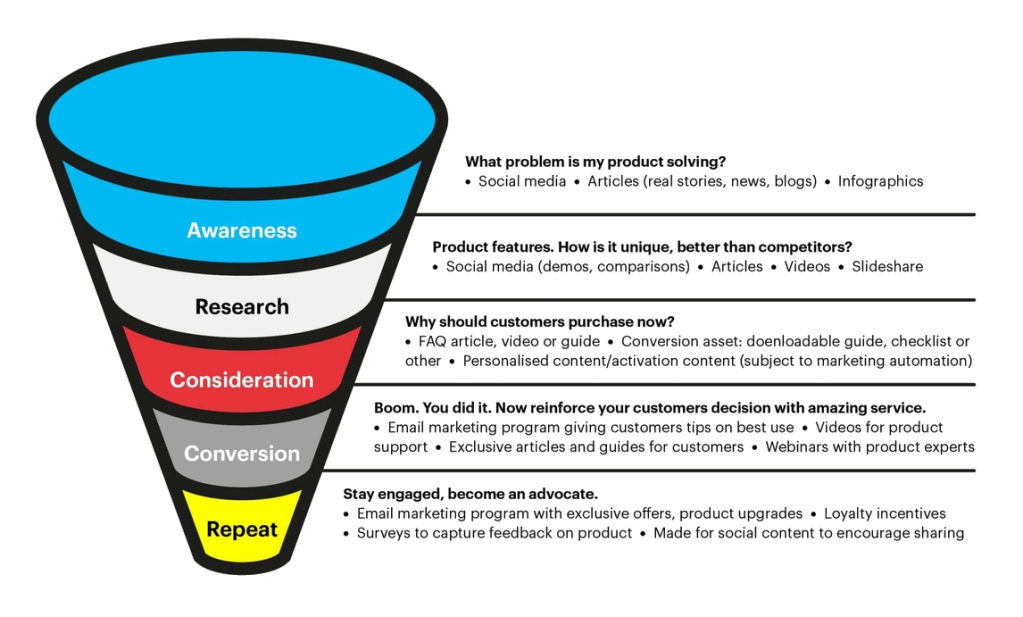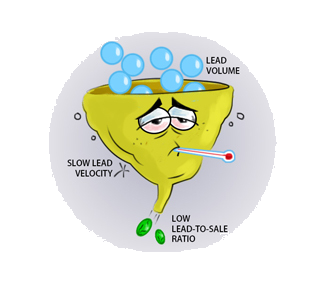When Elias St. Elmo Lewis refined his linear purchase funnel model back in the nineteenth century, sales marketing was face-to-face. It was common sales practice to develop rapport with potential customers in order to help build the trust and confidence required for conversion.
The era of digital marketing
Times have changed a lot since then. Many modern businesses never meet their potential customers in person or have the ability to talk with them on the phone. As a result, the nurturing aspect of their relationship relies on whatever rapport and trust can be built over the mechanized (and oftentimes static) nature of website content and social media communications. For this reason, companies that don’t want to fall short of their digital marketing goals need frequent, new, and insightful content.
The goal of funnel marketing
The AIDA Model looks simple enough. In modern applications, the goal is for it to keep on working even when you are not working:
- to attract attention,
- build interest,
- convert interest into desire.
- convert desire into a purchase action.
Because digital lead nurturing is not the same as face-to-face lead nurturing or telephone lead nurturing, the return on funnel marketing can be dismal.
Leads generated by funnels cannot do your business any good if your target audience unsubscribes or reroutes your emails to junk mail. For this reason, I cannot overstress the importance of something I call ROB.
Retention Oriented Behaviors (ROB)
Retention Oriented Behaviors (ROB) is mindsets, attitudes, and behaviors that need to be incorporated into your digital marketing plan before the point of first contact, and not at the point of conversion (via inquiry forms on your website and Facebook) as suggested by the AIDA model (below).

Funnel Failure
Funnels aid in lead generation. Your landing page, or brand presence on social media, or through specific targeted marketing (as example sponsored search engine placement), attracts and drives traffic to your website.
Leads are digitally generated by getting visitors to your website to register with a valid email address, usually in exchange for something you have offered them for free.
Here’s an example
| HOW AIDA WORKS IN THEORY |
| Attract & Drive Traffic |
| You are a graphic designer. You attract and drive traffic to your website by offering a free logo maker. As a paid sponsor, a link to your website appears on the top front page of the search engine Sally B is using. |
| Interact and Bolster Interest |
| At the moment, all you want from Sally B. is her email address. Other than asking for her email address, you ask no questions to qualify her as a potential purchaser. You follow-up with regular emails initially thanking her for registering, and then offering her upsells. |
| Heightened Customer Desire Leads to Conversion |
| NO CONVERSION |
| HOW AIDA WORKS IN REAL WORLD |
| Sally B. is searching for a free logo. She sees your link for a free logo maker, and clicks on it. |
| When Sally B. arrives at your site, your settings allow her to start making a free logo. But, to download it, Sally must register with a valid email address. Sally registers and downloads the free logo. She does not browse your site to see what else you have to offer. She gets what she came for, and leaves. |
| Soon tiring of your emails, which she never reads, Sally B. marks them as junk mail. |
You talk the talk, but do you walk the walk?
A clear issue surfacing in the theory vs. real world chart, is this: No effort was made to qualify Sally B. as a potential purchaser.
Whatever you say about your company, you’ve already exposed a flaw in your digital marketing strategy by failing to qualify traffic to your website before adding it to mailchimp.
The value of surveys and polls
How are you going to find out about things if you don’t ask questions? Although I wouldn’t suggest asking a woman her exact age or weight, the more information you have about a potential conversion, the better equipped you will be to meet his or her needs. Or maybe the visit to your site has a specific purpose, and your potential conversion won’t be back after that purpose is fulfilled. Simple polls and surveys will provide you with useful information, and assist you in customizing your email accordingly.
Knowing something about your potential conversion, is a part of ROB strategy. Understanding how to establish a rapport is crucial in relationships. Thanking a visitor for their interest and inviting them to return soon leaves your visitor with a good impression of your brand and style.

Sincerity is key
Retention Oriented Behaviors like complimenting someone, or asking how their mother is doing, were used to establish rapport and build trust in the ninetieth and twentieth centuries. Digital marketing in the twenty-first century does not allow for such luxuries.
The right questions will help you break down barriers. You will connect with traffic to your site, and potential conversions,
Whether you spend $200, $2000, $20,000 or $200,000 to bring potential business to your threshold, keeping it there long enough to convert it into a sale happens more easily through a seamless use of ROB.

Do you need content? I can help.
Email me today – contact@insidemyoffice.ca.
UNLESS STATED OTHERWISE All content on this site is written & edited by: J. Emily Somma, BA Copywriter & Editor Inside my Office © 2021
USEFUL LINKS:
Eleven Powerful Tips for Building Customer Rapport
FIVE Fundamental Questions For Qualifying Your Ideal Customers
